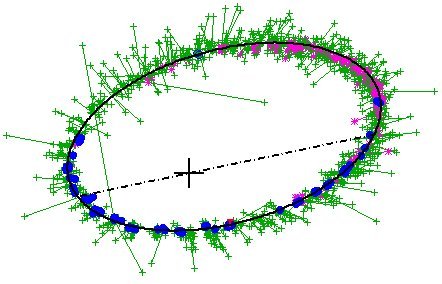
 |
Xi UMa B orbits Xi UMa A every 59.84 years. The orbit (five seconds of arc across and the best fit to the observations) is seen as projected through 122 degrees onto the plane of the sky (making "B" appear to go around "A," at the cross, in the clockwise direction), which offsets the primary star from the focus of the ellipse. The dashed line is the true major axis of the rectified ellipse, what we would see were the orbit viewed from overhead. The two stars were closest in February of 1995. (From an article in the Astronomical Journal by B. D. Mason, H. A. McAlister, W. I. Hartkopf, and M. M. Shara, as presented and modifed by W. I. Hartkopf and B. D. Mason, US Naval Observatory.) |